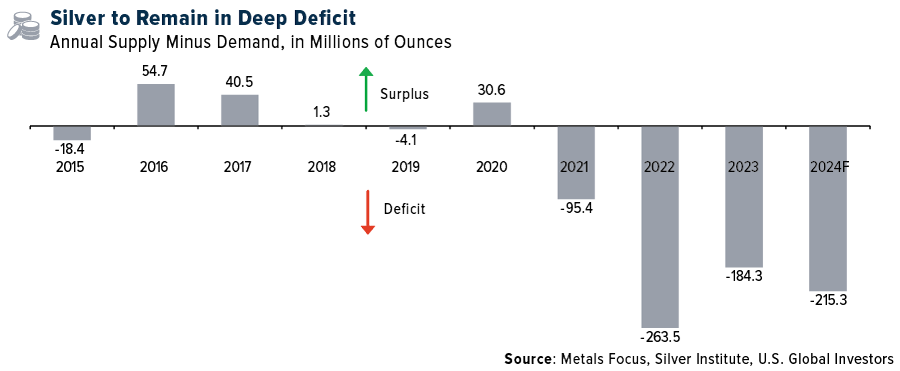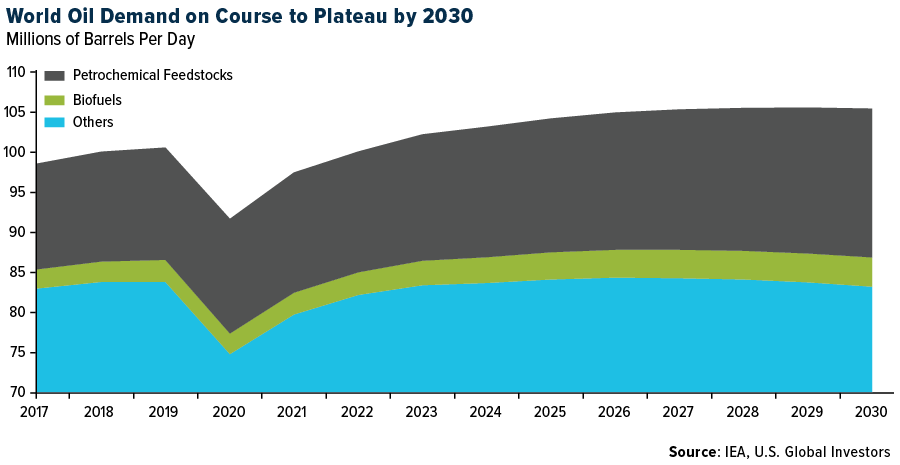Silver Deficit, Gold $2700, and the Coming Oil Glut
Reviewing H1 2024's commodity winners...
IF YOU were in charge of the Fourth of July spread this holiday, you probably noticed a hike in prices, says Frank Holmes at US Global Investors.
According to the American Farm Bureau Federation, the cost of a typical Independence Day spread for 10 people jumped to $71.22 this year, up 5% from last year and a whopping 30% from five years ago.
That may not seem like much, but this inflation has a compounding effect on commodities.
Research from Goldman Sachs shows that a 1 per centage point increase in US inflation has historically led to a real return gain of 7 per centage points for commodities. Meanwhile, the same trigger caused stocks and bonds to decline by 3 and 4 per centage points, respectively.
This data supports the potential of commodities as an inflation hedge. In times of rising prices, having exposure to tangible assets like silver, oil and gold often retain their value better than paper assets.
The reason I mention silver, oil and gold is because they were the top performing commodities in the first half of 2024. Let's dive into what's driving these trends and what they might mean for investors.
Leading the charge is silver, up close to 22.5% in the first half. The "poor man's gold" is proving its worth, driven by a global supply deficit and increasing demand.

Back in January, the Silver Institute forecasted that global silver demand will reach a near-record 1.2 billion ounces in 2024, up 1% from last year. This growth is primarily fueled by industrial applications, particularly in the booming solar energy sector.
We're looking at the fourth consecutive year of a structural market deficit in silver. The deficit is expected to widen by 17%, reaching 215.3 million ounces. Loyal readers should be aware of what happens when demand outstrips supply – prices tend to rise.
Oil, our second top performer with a gain of 13.8%, continues to demonstrate its staying power in the global economy. Despite the push for electrification, oil demand remains robust.
According to a new report by the International Energy Agency (IEA), we're approaching a significant turning point. Global oil demand, which averaged just over 102 million barrels per day in 2023, is expected to level off near 106 million barrels per day toward the end of this decade. This plateau in demand coincides with a projected surge in global oil production, particularly from non-OPEC+ producers.

The implications of this forecast are profound. We're looking at a future where oil supplies could reach levels of abundance unseen outside of the pandemic. This potential oversupply situation could exert downward pressure on oil prices.
It's worth noting that the IEA's outlook contrasts with some other forecasts. Goldman Sachs Research, for instance, expects oil demand to continue growing until 2034, potentially reaching 110 million barrels a day. They cite increasing demand from emerging Asian markets and the petrochemical industry as key drivers.
Last but certainly not least is gold. The yellow metal has shone brightly in 2024, rising 12.8% year-to-date and outperforming many major asset classes. This performance is particularly impressive given the high interest rates and strong US Dollar – conditions that ordinarily create a challenging environment for gold.
What's behind the metal's resilience? It's a perfect storm of factors: continued central bank buying, strong Asian investment flows, steady consumer demand and persistent geopolitical uncertainties. In its midyear outlook, the World Gold Council (WGC) estimates that central bank demand alone contributed at least 10% to gold's performance in 2023 and potentially around 5% so far this year.
Looking ahead, Goldman has set a bullish target of $2700 per troy ounce for gold by year-end. That's an increase of about 16% from current levels. They cite solid demand from emerging market central banks and Asian households as key drivers.
Many investors, myself included, appreciate gold's potential as a hedge against both inflation and geopolitical risks. It could provide a buffer against potential stock market volatility, especially if trade tensions escalate. Additionally, gold might see further upside if concerns about the US debt load increase or if there's a shift in Federal Reserve policy under a new administration.
As we move into the second half of 2024, the commodities market continues to offer intriguing opportunities. Silver's industrial demand, particularly in the green energy sector, presents a compelling growth story. Oil remains a critical resource, especially for emerging economies, despite the global push towards renewables. And gold, the eternal safe haven, continues to prove its worth in uncertain times.












 Email us
Email us
